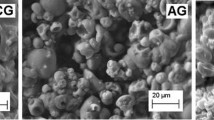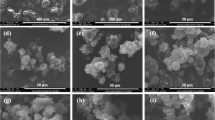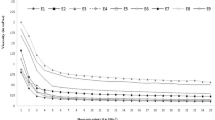Abstract
The aim of the study was to assess the effects of modification of encapsulant materials before emulsion formation on the viscosity and interfacial properties of the emulsions and their influence on the susceptibility of emulsions to in vitro lipolysis. Emulsions (oil/protein ratio 2:1) were prepared by homogenizing mixtures containing fish oil and non-heated or heated (100 °C/120 min) dispersions comprising (a) sodium caseinate (NaCas), (b) mixtures of NaCas and a high amylose-resistant starch (Hylon VII; 1:1 mass ratio), and (c) mixtures of NaCas and previously modified resistant starch (heat/microfluidized [MF] Hylon VII; 1:1 mass ratio), followed by freeze drying. Reconstituted emulsion containing heated mixture of NaCas and heat/MF Hylon VII was the most viscous. The extent of lipolysis was the same in all emulsions stabilized by non-heated NaCas or non-heated mixtures of NaCas with resistant starch. Heat treatment of NaCas increased lipolysis of emulsions stabilized with protein alone, but heating NaCas with Hylon VII or heat/MF Hylon VII before emulsion formation reduced lipolysis. The emulsion stabilized with the heated NaCas–heat/MF Hylon VII mixture was the most resistant to lipolysis. Overall, the resistance to lipolysis was considered to be primarily dependent on the interfacial properties of the microcapsules. These findings of in vitro lipolysis of NaCas-resistant starch formulated oil powders may be relevant to an understanding of in vivo digestibility of the oil powders. The insights may be used as a guide to formulate oil systems for altering the susceptibility to lipolysis of ingested oil emulsions.


Similar content being viewed by others
References
L. Sanguansri, M.A. Augustin, Microencapsulation and delivery of omega-3 fatty acids, ed. by Shi J. In Functional Food Engineering Technologies and Processing (CRC Press, 2006), pp. 297–327
C.P. Champagne, P. Fustier, Microencapsulation for improved deliver of bioactive compounds into foods Curr. Opin. Biotechnol. 18, 184 (2007)
G. Piéroni, Y. Gargouri, L. Sarda, R. Verger, Interactions of lipases with lipid monolayers. Facts and questions Adv. Colloid Interfacial Sci. 32, 341 (1990)
M. Wickham, M. Garrood, J. Leney, P.D.G. Wilson, F. Fillery-Travis, Modification of a phospholipid stabilized emulsion interface by bile salt: effect on pancreatic lipase activity J. Lipid Res. 39, 623 (1998)
S. Mun, E.A. Decker, Y. Park, J. Weiss, D.J. McClements, Influence of interfacial composition on in vitro digestibility of emulsified lipids: potential mechanism for chitosan’s ability to inhibit fat digestion Food Biophysics 1, 21 (2006)
M. Armand, B. Pasquier, M. Andre, P. Borel, M. Senft, J. Peyrot, J. Salducci, H. Portugal, V. Jaussan, D. Lairon, Digestion and absorption of 2 fat emulsions with different droplet sizes in the human digestive tract Am. J. Clin. Nutr. 70, 1096 (1999)
Y. Gargouri, G. Piéroni, C. Riviere, L. Sarda, R. Verger, Inhibition of lipases by proteins: a binding study using dicaprin monolayers Biochemistry 25, 1733 (1986)
B. Pasquier, M. Armand, F. Guillon, C. Castelain, P. Borel, J. Barry, G. Pieroni, D. Lairon, Viscous soluble dietary fibers alter emulsification and lipolysis of triacylglycerols in duodenal medium in vitro Nutritional Biochemistry 7, 293 (1996)
M.A. Augustin, P. Sanguansri, A. Htoon, Functional performance of a resistant starch ingredient using a microfluidiser. Innovat. Food Sci. Emerg. Tech., 9, 224 (2008)
Y.W. Shu, S. Sahara, S. Nakamura, A. Kato, Effects of length of polysaccharide chains on the functional properties of the Maillard-type lysozyme–polysaccharide conjugate J. Agric. Food Chem 44, 2544 (1996)
N. Diftis, V. Kiosseoglou, Improvement of emulsifying properties of soybean protein isolate by conjugation with carboxymethyl cellulose Food Chemistry 81, 1 (2003)
M.A. Augustin, L. Sanguansri, O. Bode, Maillard reaction products as encapsulants for fish oil powders J. Food Sci. 71(2), E25 (2006)
M.A. Augustin, L. Sanguansri, R. Head, GI Tract Delivery Systems; 2003906417; 21/11/2003; Word Intellectual Property Organisation
B.S. Matiacevich, M.P. Buera, A critical evaluation of fluorescence as a potential marker for the Maillard reaction Food Chemistry 95, 423 (2006)
C. Emenhiser, M. Notturno, O. Fennema, An in vitro assay for assessing the effects of dietary components such as fiber on lipase-catalyzed hydrolysis of long-chain triaclglycerols Int. J. Food Sci. Nutr. 45, 169 (1994)
F.J. Morales, M.A.J.S. van Boekel, A study on advanced Maillard reaction in heated casein/sugar solutions: fluorescence accumulation Int. Dairy J. 7, 675 (1997)
M. Wickham, M. Garrood, J. Leney, P.D.G. Wilson, A. Fillery-Travis, Modification of a phospholipid stabilized emulsion interface by bile salt: effect on pancreatic lipase activity J. Lipid Res. 39, 623 (1998)
H. Brockman, Colipase-induced reorganization of interfaces as regulator of lipolysis Colloids Surf., B Biointerfaces 26, 202 (2002)
G.Y. Park, S. Mun, Y. Park, S. Rhee, E.A. Decker, J. Weiss, D.J. McClements, Y. Park, Influence of encapsulation of emulsified lipids with chitosan on their in vivo digestibility Food Chemistry 104, 761 (2007)
T.J. Wooster, M.A. Augustin, β-lactoglobulin–dextran Maillard Conjugates: their effect on interfacial thickness and emulsion stability J. Colloid Interface Sci. 303(2), 564 (2006)
M.R. Guo, A. Flynn, P.F. Fox, Heat-induced changes in the nutritional properties of sodium caseinate Int. Dairy J. 9, 243 (1999)
M. Beysseriat, E.A. Decker, D.J. McClements, Preliminary study of the influence of dietary fiber on the properties of oil-in-water emulsions passing through an in vitro human digestion model Food Hydrocolloids 20, 800 (2006)
Acknowledgements
C Chung gratefully acknowledges the sponsorship from the CSIRO Preventative Health Flagship and the Faculty of Land and Food Research for her postgraduate study. The authors would like to thank T. J. Wooster for helpful comments.
Author information
Authors and Affiliations
Corresponding author
Additional information
Delivery of Functionality in Complex Food Systems: Physically inspired Approaches from Nanoscale to Microscale, University of Massachusetts, Amherst, MA, USA, 8th–10th October 2007.
Rights and permissions
About this article
Cite this article
Chung, C., Sanguansri, L. & Augustin, M.A. Effects of Modification of Encapsulant Materials on the Susceptibility of Fish Oil Microcapsules to Lipolysis. Food Biophysics 3, 140–145 (2008). https://doi.org/10.1007/s11483-008-9069-4
Received:
Accepted:
Published:
Issue Date:
DOI: https://doi.org/10.1007/s11483-008-9069-4




